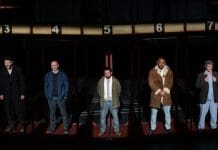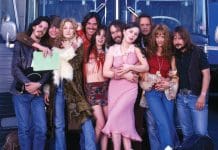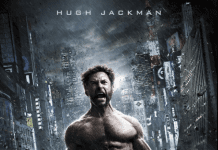WWF Royal Rumble 1996
WWF Royal Rumble 1996 is an intriguing show to reflect upon. It occurs right at the height of the New Generation, and yet it’s a night which shows some of the very first hints of the wilder and more mature Attitude Era that was set to come further down the line (the “viewer discretion advised” message from Sunny, who is chilling in a bath-tub, at the very beginning is out of character for the family-friendly WWF, for starters), though this doesn’t change the fact that the show overall was a bit disappointing, as I will explain.
Free For All Match – Royal Rumble Implications
Hunter Hearst Helmsley vs. Duke Droese
Previously, many WWF supershows had included a dark match for the live crowd, but this was the first time that a pre-show bout was officially televised live (on The Preview Channel in the United States), and these contests would have actual significance too, paving the way for the Kick-Off Show that we have become accustomed to nowadays. In this case, the stipulation was unique, because the winner would earn the #30 spot in the night’s Rumble match, whilst the loser would have to enter at #1. I’m not sure how these two were picked out for what could give them the greatest or slimmest chance of having their hand raised in victory at the end of the card. Mind you, Helmsley clearly didn’t place huge importance on his entry spot, because he clocked Droese with brass knuckles to get disqualified. These two would meet again, on the main show this time, at In Your House VI.
Ahmed Johnson vs. Jeff Jarrett
Onto the PPV now (which incidentally debuted a new logo and new banners for the Rumble; they looked awfully similar to the logo for Toy Story, which had recently been released to massive popularity), and the show began with Ahmed vs. Double J. Jarrett had returned following a hiatus at In Your House V, where he broke a platinum record frame on Johnson’s chrome dome. This was Ahmed’s chance for revenge at a time when he was really getting over, but it came with the caveat that he would not be entering the main Rumble match. He probably wished he’d made a different decision because this was an average match, and it ended with another disqualification: this time, Jarrett picked up his guitar, headed up to the top rope and smashed it over Ahmed’s head. Making matters worse for Johnson, Jarrett would leave the WWF again shortly thereafter, this time heading to WCW where he remained until the autumn of 1997. Still, this was a mildly shocking moment for the WWF of 1996.
WWF World Tag Team Championship Match
The Smoking Gunns (C) vs. The Body Donnas
Next up, the babe from the bath-tub Sunny brought her charges Skip and Zip (who I thought for the longest time was Fit Finlay, but was actually Tom Prichard, somehow) to challenge Billy Gunn and Bart Gunn for the doubles titles. This was a fairly decent match, at least by the tag team standards of the time, though it wasn’t anything to tell your friends about (mind you, would you really tell your friends about a Body Donnas bout?). The Gunns retained, but for the second straight match, a twist of fate was to come, this time impacting the winners: an injury to Billy meant that the titles would be vacated, and The Donnas would end up capturing them at WrestleMania XII (on the Free For All).
WWF Intercontinental Championship Match
Razor Ramon (C) vs. Goldust
At the time of Royal Rumble 1996, the Goldust character was relying heavily on moderate-to-strong homosexual innuendos as a way to garner heel heat, which didn’t go down well in 1996. Not least with Razor, who supposedly was angry at having to wrestle the real-life Dustin Runnels due to the nature of his gimmick. This probably meant that their match wouldn’t be the best that you’ve ever seen, and so it proved. It had its, erm, moments, but it was a forgettable contest, in spite of such moments as Goldust rubbing his hands on Ramon’s pectorals, with Razor immediately shoving him away. Making things more intriguing was the presence of Marlena in Goldust’s corner; her debut called into question whether Goldust really was gay or whether he was just playing psychological mind games to get into the head of his opponent. Suffice it to say that this character would not go down well in 2020 (hell, it resulted in a lot of complaints in 1996, though sadly not all of the angry parties were on Goldie’s side). Anyway, after Marlena distracted the official, 123-Kid came flying off the top rope with a kick to knock down Razor just long enough for Goldust to pin him and win the IC prize in a fairly big upset, which demonstrated Vince McMahon’s commitment to the character. Mr. Perfect on commentary noted “now Goldust has all the gold!” (Strange side note: the first twelve Rumble events had twelve different announcer’s teams; while Gorilla Monsoon and Bobby Heenan called both the 1992 and 1993 cards, the 1994 show actually had two squads, with Gorilla and Jim Ross covering one match, Razor’s funnily enough, while Vince and Ted DiBiase announced the rest.) Razor had seemingly lost the IC crown for the third straight Rumble, and for the second straight year, the result counted, divorcing Ramon from the IC belt for good.
Royal Rumble Match
Before the match, we had the welcome return of the pre-taped wrestler comments, though they didn’t quite have the same impact as those in the Golden Age. As noted earlier, Helmsley was #1, and Henry Godwinn was #2 to kick-start the Royal Rumble 1996 match. Godwinn had fought Hunter recently in a Hog Pen match, so it was fitting that H.O.G. would manage to draw number two (wink, wink). They were joined by Bob Backlund (in one of his final WWF in-ring appearances, at least as a proper wrestler) and Jerry Lawler, although all three heels retreated when Henry got hold of his slop bucket, and he poured it onto the villains at ringside. Bob “Spark Plugg” Holly was #5 (not a vintage line-up so far), followed by King Mabel at #6; both Mabel and Sir Mo would be out of the company shortly afterwards (did the WWF have a spring cleaning in early ’96?). Entrant seven was more noteworthy: it was Jake Roberts, making his WWF return, and as a babyface for the first time since 1991. He brought a new, long, yellow snake named Revelations based on him finding God, and he hurled the snake into the ring, soon setting the python on Lawler in a memorable moment. The King used this as an excuse to retreat under the ring, thus creating the incident which he still discusses on commentary to this day.
Dory Funk Jr. was number eight, as the first of numerous “outsiders” brought in, presumably to pad out the field (that the WWF didn’t have enough talent to provide 30 bodies, even considering those who were competing on the under card, is a reflection of the times). Yokozuna came in at number nine, and at this stage, he was beginning to be phased down and eventually out, primarily due to the very thing that got him attention in the first place, that being his gargantuan size. Mind you, Yoko did eliminate Mr. Backlund, meaning that almost a third of the Rumble had elapsed before somebody went out, which may be a record. Next in was 123-Kid, but he was chased in and around the ring by an angry Razor, which marked the closest thing we got to Scott Hall entering a Rumble bout. In the meantime, Jake eliminated Henry, meaning that there were eight guys in the ring at this moment.
It might as well have remained at eight because the next entrant was Omori of, erm, who is Omori exactly? At least Funk had considerable name value to longtime wrestling fans, whereas Omori was and remains a complete unknown to anyone who doesn’t watch Japanese wrestling. Savio Vega was thankfully a recognisable entrant at #12; at this time, Yoko managed to eliminate Mabel, which is both impressive and logical. Omori was eliminated by both Hunter and Jake (why did it take two guys to dispose of him?). Number thirteen was Vader, making his WWF debut, and he had been built up well enough that this was significant, not least due to his clearly intimidating frame (if we ignore that he somehow had his singlet on back-to-front). Vega eliminated Funk, and after the third “visitor” in Doug Gilbert entered (Perfect on commentary said “who’s that guy?” before recognising the name after Vince told him who it was), Vader knocked out Roberts, just as he was planning to DDT Doug. Gilbert wasn’t safe for long, though, as The Mastadon tossed him out. Two more randoms came in: unidentified members of the “Squat Team”, with Vader eliminating one, then the other walking in just as the first guy was leaving, and Yoko tossed the second member as well. It looked amusing as they were twins, but even so, the Rumble was dragging badly at this stage, largely because people were entering that fans had never heard of, and in most cases, they would never hear of them again.
Owen Hart thankfully gave the Royal Rumble 1996 match some more importance as number seventeen, before the real star of the show arrived at #18: Shawn Michaels. HBK had won the 1995 Rumble but lost his Mania title shot to Diesel, then turned babyface and spent much of 1995 building up his stock as the next “guy”. In October, he was attacked by a bunch of Marines, returned but then immediately shelved when he collapsed in a match (an angle, though I and a lot of others believed it at the time) against Owen, suffering from post-concussion syndrome. Doctors on-screen advised Shawn to quit, but he said no to that, and vowed to return, win the Rumble and become WWF Champion at long last at WM XII. Therefore, he was the sentimental favourite, if not the only possible favourite, and so when he arrived, fans were more than happy to see him.
Vader threw out Vega next, and then he slugged it out with Yoko, removing his mask in the process. The two behemoths battled near the ropes, which allowed Michaels to scoop them up and eliminate both at once in the big moment of the match, drawing major cheers. Shawn then threw out The Kid, but Vader wasn’t done: he climbed back in and threw everybody out, which included gorilla pressing Shawn to the floor. Now, these moments should have counted as eliminations, but the WWF rulebook must have been tweaked (wink, wink), because those who the bullying monster Vader had attacked were allowed to re-enter. This included Hakushi, who picked a bad time to run down the aisle with a beast on the loose. He didn’t last long either as Owen threw him out. Tatanka was next in, followed by Aldo Montoya (near-silence from the crowd) and Diesel, which woke up the audience. Vince: “well, well, well!” Diesel had lost his WWF Championship to Bret Hart at Survivor Series 1995, and was a tweener at this stage, a big man with a chip on his shoulder. If Shawn didn’t win the Rumble, it would likely be Big Daddy Cool, but remember that they were still on-screen buddies at this stage.
After Montoya was thrown out by Tatanka, Shawn retrieved a hiding Lawler from under the ring and brought him back in just to throw him out officially; meanwhile, Diesel claimed his first elimination in Tatanka. A bald-headed Kama arrived (another guy who would disappear for a while after this event), followed by a guy with a short haircut who would go bald later in the year, The Ringmaster a.k.a. Steve Austin. This was Stone Cold’s Rumble bow, and whilst he obviously didn’t dominate like he would do in the future, he did get a moment of sorts by throwing out Holly, who had somehow lasted all this time. Speaking of long-lasting guys, Helmsley had survived since entering at number one, but Diesel would be the one to send the future Game flying after the longest stretch of any 1996 Rumble participant. Barry Horowitz made his only Rumble appearance (and as the recent recipient of a push, his inclusion made sense), followed by Fatu, Isaac Yankem DDS (it’s law to remind you that Yankem later became Kane) and Marty Jannetty, who had a showdown with Shawn (I forgot to mention that Diesel clocked Michaels at one point to let him know that, friendship aside, it was every man for himself here).
In terms of further eliminations, Barry went out courtesy of Owen, before Hart himself was eliminated by both Diesel and Shawn. The British Bulldog came in at #29 and made an immediate impact by throwing out Marty; during this stage, Ringmaster was eliminated by Fatu, though Steve Austin has since stated that he was meant to hold on and last until the final four, but instead, he lost his grip and fell out. Had he survived, he would have made the final four of all six Rumbles he entered, winning three of them and making it to the last two in another year. On consistency, Austin is the best Rumble participant ever anyway, but without this botch, his RR legacy might have been even stronger.
As noted earlier, Duke Droese was #30, taking us to the home stretch of the Royal Rumble 1996 match. Yankem disposed of Fatu, before Michaels tossed out the dentist. Diesel and Kama formed a random team to eliminate The Dumpster (yup), before a sudden end to the match: Shawn was in danger but smoothly slid back in under Bulldog’s legs to clothesline him out, at which point Diesel knocked out Kama (presumably acting in Ringmaster’s place). Almost instantly, Shawn then superkicked Diesel (well, his foot came about a foot away from Diesel’s jaw which was apparently enough contact) to the floor, making Michaels the winner of the Rumble. Shawn celebrated by stripping a bit and showing the crowd a bit of his arse (I kid you not), before Diesel came back in, livid. Would he attack Michaels? No: instead, he reluctantly endorsed him, though he did pummel a still-recovering Bulldog at ringside. In the end, he stayed around long enough to meet The Undertaker, who was in the last match; the two big men had a brawl in the aisleway (they had a minor confrontation at the end of In Your House V), and this wasn’t the last we would see of Diesel on this show.
WWF Championship Match
Bret Hart (C) vs. The Undertaker
Normally, there would be a lot to say about a Bret Hart-Undertaker match, especially here where they met for the first time on Pay-Per-View. Unfortunately, this Royal Rumble 1996 encounter was a rare PPV stink-bomb for both men (well Bret more so, since Taker was largely forced to face lumbering giants at this stage), as it was well-executed but rather dull to watch. Other than Bret removing Taker’s creepy face-mask (which he had donned following a facial injury in the autumn), nothing of particularly high significance happened until the finish, which I’ll skip ahead to: Taker Tombstoned Bret and seemingly had the title won, only for Diesel to interfere to cost Taker the gold. Post-match, Diesel gave Taker a middle-finger salute, which was shocking in the WWF of January 1996. Little did we know that this was a sign of things to come. Taker walked backstage angrily following Diesel, setting up a showdown at WM XII. Bret retained, but he didn’t look like much of a champion, something he wasn’t very happy about to say the least. He was probably unhappy at the match quality too, and for the first Rumble PPV to have a regular main event match, it all just felt really odd in the end.
Overall, WWF Royal Rumble 1996 is not actively bad, but it is a chore to sit through. The under-card doesn’t have much in the way of noteworthy action, and the main event should have been great but ends up being forgettable (aside from Diesel flipping off Taker). As for the Rumble itself: it was an improvement on the previous year and there were some cool moments, but it felt a bit too predictable, and the abundance of no-names entering the field didn’t help. So, yeah, Royal Rumble 1996 more or less came and went, but at least some small teasers were dropped about the rebellious years to come for the WWF.









